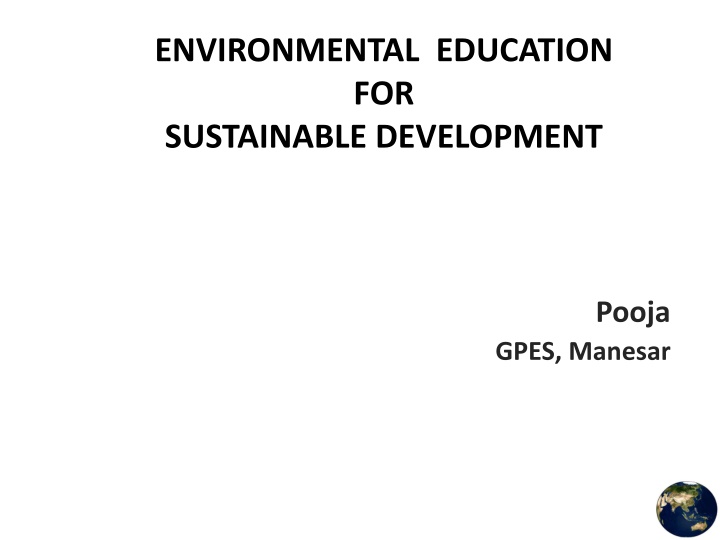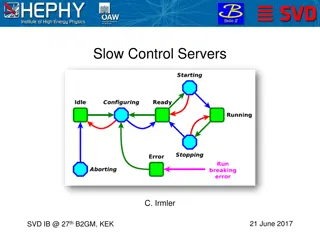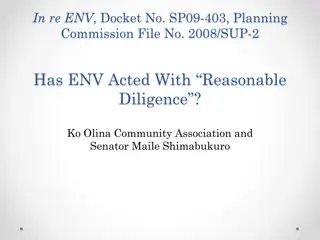
Environmental Education for Sustainable Development - Overview of Ecology, Biodiversity, Pollution, and Impact of Global Warming
Explore the importance of environmental education for sustainable development through an overview of ecology, biodiversity, pollution, and the impact of global warming. Learn about the relationships between organisms and their environment, the diversity of life on Earth, the components of biodiversity, and the effects of global warming such as ice melting and rising sea levels. Discover the challenges posed by air and water pollution, as well as the occurrence of natural calamities like tsunamis. Gain insights into today's environmental problems and the urgent need for action to combat pollution and protect our planet.
Download Presentation

Please find below an Image/Link to download the presentation.
The content on the website is provided AS IS for your information and personal use only. It may not be sold, licensed, or shared on other websites without obtaining consent from the author. If you encounter any issues during the download, it is possible that the publisher has removed the file from their server.
You are allowed to download the files provided on this website for personal or commercial use, subject to the condition that they are used lawfully. All files are the property of their respective owners.
The content on the website is provided AS IS for your information and personal use only. It may not be sold, licensed, or shared on other websites without obtaining consent from the author.
E N D
Presentation Transcript
ENVIRONMENTAL EDUCATION FOR SUSTAINABLE DEVELOPMENT Pooja GPES, Manesar
INTRODUCTION About Ecology Biodiversity About Pollution Role of Environment Education
Overview of Ecology Ecology: Study of relationships between organisms and the environment. Simple definition does not convey the extreme breadth of this discipline. Ecosystem: Includes all organisms living in an area, and the physical environment with which these organisms interact.
Biodiversity is the variety of life on Earth and the essential interdependence of all living things (www.thecatalogueoflife.org) Scientists have identified more than 1.4 million species. Tens of millions -- remain unknown The tremendous variety of life on Earth is made possible by complex interactions among all living things including micro- oganisms.
There are 3 components of biodiversity 1. Diversity of genes- Chihuahuas, beagles, and rottweilers are all the same species but they're not the same because there is variety in their genes. Diversity of number of species- For example, monkeys, dragonflies, and meadow beauties are all different species. Variety of ecosystems- Lakes, Ponds, and Rivers are all Freshwater Ecosystems. Rocky coast, Sand Dune, Estuary, Salt Marsh , Coral Reef are all Marine Ecosystems. 2. 3.
EFFECT OF GLOBAL WARMING Melting of Ice in North and South Pole. All the Water Drained to Sea. Rise in Sea Level. So, What is Effect?
Natural Calamity - TSUNAMI For Example Effects: 26 December 2004
TYPES OF POLLUTION Every day, earth becomes more and more polluted. Air pollution fills our lungs with deadly substances. Water pollution is rapidly eradicating what little freshwater we have left. Land pollution is causing once-fertile lands to become little more than deserts
Awareness about the following issues are needed. Difference between sustainable development and environmental sustainability. Unique definition for sustainable development Will depending on Science and Technology alone deliver environmental sustainability?
Sustainable development and environmental sustainability Definition for sustainable development : Development that meets the needs of the present without compromising the ability of future generation to meet their own needs The resource base is not inexhaustible sustainable development is economic development Without environmental sustainability it is impossible to achieve sustainable development.
Unique definition for sustainable development: An indicator is needed for comparing the relative progress made by different countries towards sustainable development at a given time or for measuring progress made by a given country or region over time.
operational definition must be based on the reduction in consumption of goods and services by the affluent within and between nations. The production and consumption must be curbed to achieve even a modest degree of sustainable development and determined efforts must be made to reduce consumption through formal education
Science, technology and environmental sustainability Role of science and technology in delivering environmental sustainability: sustainable development and global environmental sustainability achieved not only with the application of science and technology alone. Example : USA progress towards sustainable development is dependent upon a fundamental change in societies attitude to nature and the environment to bring about this change of attitude is education in moral and ethical philosophy. In the young minds it is essential to reinforce the environment-respecting moral values.
Can science and technology deliver sustainable development impacts of science and technology turnout to be good or bad is determined by their environmental impacts. economic development through industrialization World Bank and International Monetary Fund
Benefits of Science paying a high price for it in terms of environmental degradation this has serious implications for future generations. science and technology can help the process of sustainable development in a limited way but they cannot deliver them.
NEED FOR ENVIRONMENTAL EDUCATION All major natural resources in the country are in grave danger of irreparable damage. A society cannot survive if its natural resources are rendered unfit for use by its people. The only hope of salvaging this grave situation is by making the young aware that they need to proactively begin to protect the environment they will inherit. Science and Technology can help in a limited way but cannot deliver it.
NEED FOR ENVIRONMENTAL EDUCATION (Contd.) The moral and ethical education for changing people s attitude To protect children living in polluted regions, environmental education represents a relevant means of prevention It is need for the hour to propose the environmental education with the essential elements of moral philosophy. For conceptual change
Essential components Of The environmental education Alerting the public to the need to achieve global sustainale development and the likely consequences of failing to do so. Focusing the educational curricula for global sustainable development by incorporating the know how and skills and also the moral imperatives.
Curriculum development Reasons for including moral education in Engineering Curricula: As future planners, designers, builders and decision makers , students shoulder special responsibility in protecting the integrity of nature and the natural environment. Human beings are rational creatures who have an innate need to rationalize all their actions and thoughts .Moral philosophy provjdes this rationale, and by doing so gives us our humanity. Albert Einsteins statement Science without philosophy is just mechanics .
Criteria for curriculum development: The focus must be on reducing consumption with a view to achieving sustainability. The content should be holistic, covering all essential aspects. The content should comprises two strategic elements: The end- of- the pipe element based on science and technology to deal with pollution already produced. The before-the-pipe element concerned with pollution prevention and reduction.
MAJOR AREAS TO BE COVERED Curriculum units and materials have to be developed in five areas: 1. Air Quality 2. Ecosystems & Biodiversity 3. Energy Resources 4. Land Use 5. Water Quality
CURRICULUM Air - acid rain, indoor air pollution, ozone, radon Conservation - energy, environmental stewardship, natural resources, pollution prevention Ecosystems - ecology, endangered species, global warming, habitats, watersheds Human Health - drinking water, fish advisories, indoor air, lead, ozone depletion, pesticides, radon, smog In Your Neighborhood - databases, local issues, maps Waste & Recycling - garbage, household, hazardous & solid waste, landfills, superfund cleanups, trash Water- drinking water, ecosystems, lakes, oceans, rivers, water pollution, watersheds
IMPORTANCE OF WATER RESOURCES According to the latest census of India statistics, only 38 percent of the 192 million households in India enjoy the privilege of grossly under-priced piped water supply. Water is a resource which is much too free. Under-pricing of this vital resource has ironically put it beyond the reach of the poor majority. A resource conscious society should carefully calculate the cost and price of its natural resources. Since we haven t done so, there s a lot of pilferage and waste. Water should be a costed resource, only then will we use and save it as a precious resource. Water management should receive top priority as environment education is introduced in schools and colleges
Though children and youth in rural India are physically closer to nature, they seldom have access to natural resources to satisfy their basic needs. For instance though they may live beside a river, it s rare for rural youth to have experienced piped water. Instead river water is transported across hundreds of miles to cities. Continuous mismanagement and waste of water resources and years of large-scale deforestation has transformed India from a once water-rich society into a water- insecure nation.
The people below are taking care of their home and car, but they are doing many things that can damage the environment, especially our water.
Todays status of Environmental Education While environment education is a compulsory subject in schools, Children are just mugging another subject environment studies. For example the prescribed curriculum won t help a student in getting a mound of rubbish outside a house or school cleared. Students are being taught mere facts and figures. We have to make our children to realise that they are part of the problem, and therefore they have to be part of the solution
Effective Handling of EE Mandating environment education as a boring study subject is the best way to kill it. Instead it should be introduced as a voluntary, extra- curricular activity to arouse the interest and awareness of students in green issues. Indeed environment education as a hands-on extra-curricular activity rather than an academic classroom subject is arousing growing enthusiasm across the country. Enhancing research activities by providing incentives
Understanding environmental behavioural change through communication Developing a responsible environmental behaviour became one of the tasks of environmental education The responsible environmental behaviour is defined as the whole of actions of an individual within the society, that takes into account, in a conscious way, the perennial and harmonious relationship between these actions and environment . Communication is a way of approaching and explaining processes in society and it can be defined as the exchange processes among the individual and group members of a given society .
Creating Environmental Awareness Global Learning and Observations to Benefit the Environment (GLOBE) (NASA), USA. Over 50,000 schools all over the world, of which 86 are in India, are enrolled in the GLOBE programme. A School in Lucknow, they have set up a small weather monitoring station in their school. Children use the station to maintain temperature and cloud charts, measure rainfall, gather weather-related information and feed it into the GLOBE website. The data is then used to forecast worldwide weather trends and to develop environment protocols,
Conclusion Effective policy must be implemented to curb consumption by the affluent We need moral education to instill genuinely environment respecting moral values in the young student society. Conventional educational methodology is no longer adequate for the real needs of tomorrow Though there are definitional and implementation flaws, environment NGOs and activists need to be given credit and accolades for creating a nation-wide awareness of the crisis of environment deterioration.
Future student generation must acquire knowledge and skills in technologies and keep pace with rapid advances in practically in all areas. The communication perspective opens the door to another kind of tools that environmental educators can use in order to improve the educational practice. Minds on experience is also needed with Hands on experience.
Education For Life Education Through Life Education Throughout Life Mahatma Gandhi











